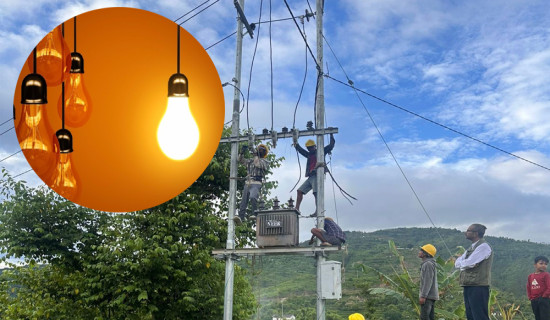- Wednesday, 26 November 2025
Prioritise West Seti Hydropower Project
The Investment Board of Nepal (IBN) has decided to award the contract for the construction of the 750 MW West Seti Hydropower Project to the National Hydroelectric Power Corporation (NHPC) Private Limited, an Indian company. The company has prepared a detailed project report (DPR). With this, a flicker of hope has emerged that the project that has been delayed for years will get constructed. It may be noted that the Indian company signed a memorandum of understanding (MOU) for the construction of the project and the 450 MW SR-6 hydel projects in Nepal with the Government of Nepal in August 2022.
The project has faced many challenges since it was proposed in 1994, when the government signed an agreement with Snowy Mountain Engineering Corporation (SMEC), an Australia-based firm. For the construction of the project, the company began preparing an environmental impact assessment (EIA) report, which was completed in 2000. The EIA report was approved by the government in 2000 itself. The report included an environmental management plan, a resettlement plan and an assessment of environmental and social impacts. The report was later updated in line with the requirements and guidelines of the Asian Development Bank (ADB). The government also inked a power purchase agreement with the Power Trade Corporation India Limited in 2003 for the purpose of exporting electricity to India.
Environmental impacts
However, the construction of the project could not proceed for various reasons. In 2010, the Asian Development Bank and the China National Machinery and Equipment Import and Export Corporation stopped showing interest in the project. Organisations opposing the project launched a campaign, expressing concern over adverse environmental impacts and the need to relocated a large number of people living around the project site. The government scrapped the construction licence of the SMEC in 2011 after the company stopped funding the project.
The IBN then selected the China Three Gorges Corporation and awarded the construction contract to the company. However, the company too turned out to be a broken reed. As such, the government revoked its construction licence, too. The government then announced that the project would be constructed as a public-private partnership with domestic resources. For this, the West Seti Hydro Limited was established, which would undertake the construction. The construction of the project was scheduled to begin in 2027 with commercial operations to start in 2031.
Meanwhile, the government changed its mind and decided to award the construction licence to India’s NHPC. The company submitted the draft of the DPR to the IBN in June 2024. The draft will be reviewed by the IBN and the Indian company will prepare the final DPR based on the suggestions and feedback given by the IBN. After the DPR has been finalised, a project development agreement (PDA) will be signed between Nepal and India. The DPR will include social, economic, technical, environmental and geological factors. It will also include the estimated cost of construction, the deadline of completion of construction, project plans, market assurance, construction of transmission lines and management of funding.
The project holds great significance. After the completion of the project, the far-west region of Nepal will greatly benefit by way of employment, education, healthcare, drinking water and, of course, electricity. The project, a reservoir-based hydel project, will also help control flooding in the region and increase the flow of water in the lower riparian areas during the dry season. As the project is being built by India, it will be easier to sell surplus electricity to India and also other south Asian countries. India is reluctant to buy electricity generated by projects financed by China and other countries.
Nepal has come a long way in the field of hydropower. The demand for electricity is growing day by day. Nepal has adopted a policy of promoting electric vehicles and household appliances so as to discourage the use of fossil fuels. Replacement of fossil fuels with hydropower, a form of renewable energy, will help cut down on carbon emissions. Nepal, already one of the lowest emitters of carbon, can generate carbon credits and uitilise the proceeds towards funding climate action. During the COP 29 conference being held in Baku, Azerbaijan, new UN standards for carbon markets have been approved.
Challenges
The West Seti Hydropower Project has faced many challenges since the inception. However, the possibility of the project being constructed has emerged. The project will also serve as a milestone in the relations between Nepal and India. This will serve to prove that India is one of the important development partners of Nepal. Although India is adamant about not buying electricity generated from Chinese-funded projects, this attitude may change when the power trade between the two countries grows further. India is a huge country and struggling to supply electricity to its 1.44 billion people. So the country is looking to Nepal for the supply of electricity.
With abundant water resources, Nepal holds the potential to develop more hydropower projects in the future. India is willing to construct hydropower projects in Nepal. It is almost certain that the project will be constructed by India. Nepal and India should also construct the Pancheshwar Multipurpose Project. The project, which is covered by the integrated Mahakali Treaty, is a bi-national project to be developed on the Mahakali River. The project has been lying fallow for years. Let’s hope that this time around the West Seti Hydropower Project will not face hurdles in the past and its construction will be completed without let or hindrance.
(Maharjan has been regularly writing on contemporary issues for this daily since 2000.)
















